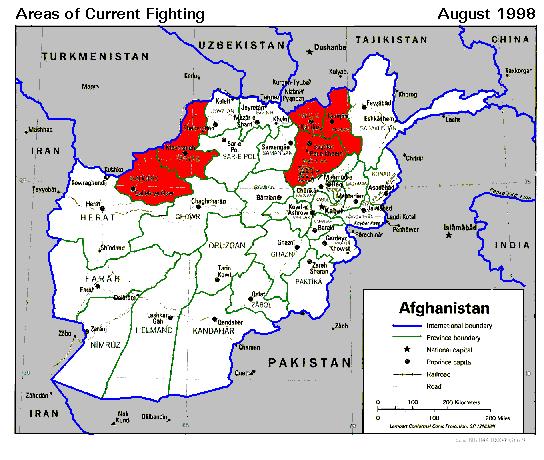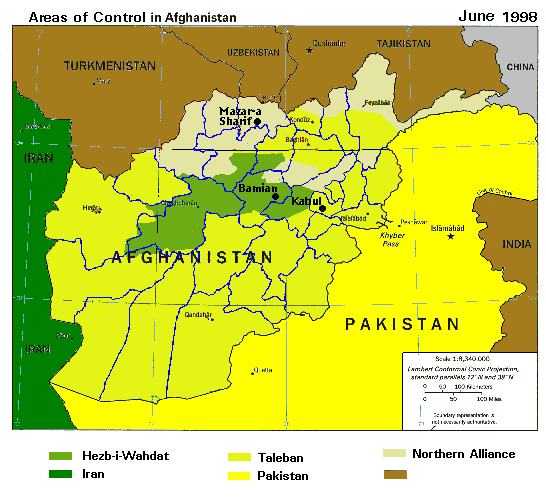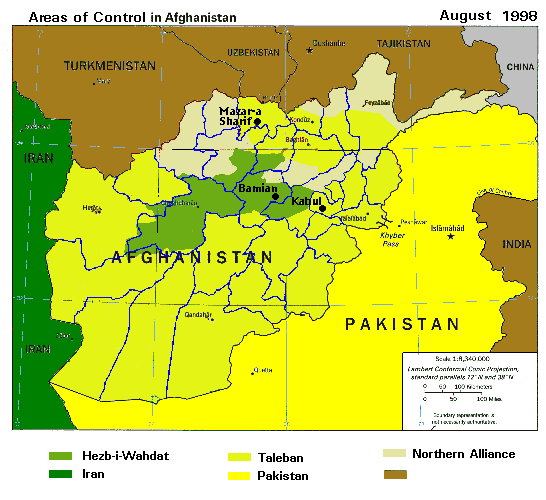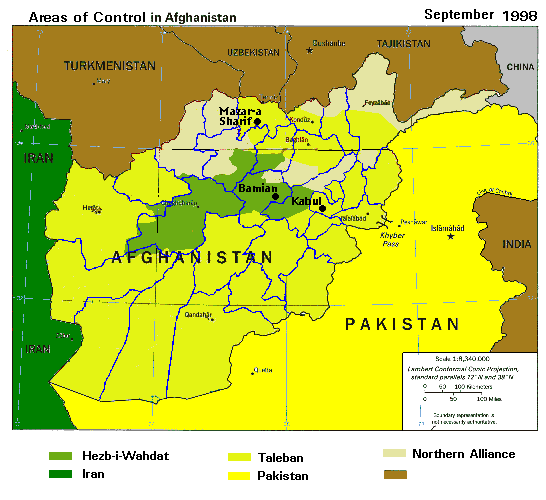




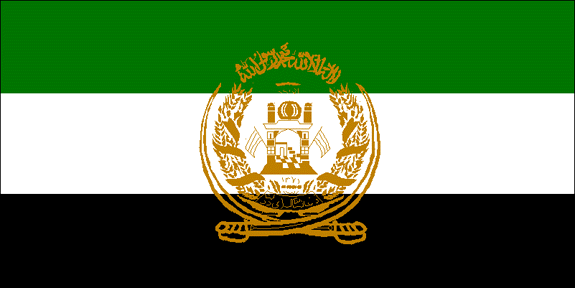
Afghanistan in 1997 continued to experience civil war and political instability. There was no central government. The mostly Pashtun Taleban forces battled the opposition Northern Alliance, which includes the country’s next three largest ethnic groups, on various fronts and as the year progressed the ethnic divide became increasingly bitter. Political killings, torture, rape, arbitrary detention, looting, abductions and kidnapings for ransom are committed by armed units, local commanders, and rogue individuals. At the end of the year, about one million Afghan refugees were believed to be in Pakistan and about 1.4 million living in Iran.
Formal economic activity remains minimal and is inhibited by recurrent fighting and roads blocked by local commanders. The northern areas all suffer from brigandage. Commercial trade is impeded in certain non-Taleban areas, as local commanders continue to demonstrate their control over the roads by demanding road tolls and sometimes closing roads. Despite these obstacles, many people continue to travel relatively freely, with buses plying routes in most parts of the country. Agriculture, including high levels of opium poppy cultivation, is the mainstay of the economy. Afghanistan remains the second largest opium producer in the world. Trade is mainly in fruits, minerals, and gems, as well as goods smuggled to Pakistan. There are also rival currencies, both very inflated.
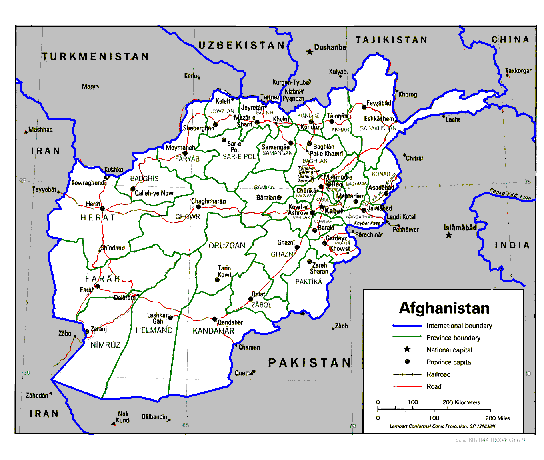

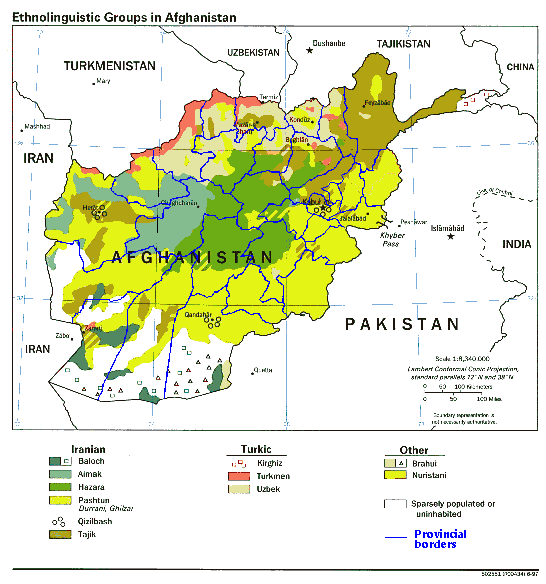
Seeking to exploit more effectively mounting popular disaffection, the PDPA reunified with Moscow's support. On April 27-28, 1978, the PDPA initiated a bloody coup which resulted in the overthrow and death of Daoud and most of his family. Nur Muhammad Taraki, Secretary General of the PDPA, became President of the Revolutionary Council and Prime Minister of the newly established Democratic Republic of Afghanistan. Opposition to the Marxist government emerged almost immediately. During its first 18 months of rule, the PDPA brutally imposed a Marxist-style "reform" program which ran counter to deeply rooted Islamic traditions.
By the summer of 1978, a major revolt in the Nuristan region of eastern Afghanistan spread into a country-wide insurgency. In September 1979, Hafizullah Amin, who had earlier been the Prime Minister and minister of defense, seized power from Taraki after a palace shootout. Over the next two months, instability plagued Amin's regime as he moved against perceived enemies in the PDPA. By December, party morale was crumbling, and the insurgency was growing.
The Soviet Union moved quickly to take advantage of the April 1978 coup. In December 1978, Moscow signed a new bilateral treaty of friendship and cooperation with Afghanistan, and the Soviet military assistance program increased significantly. The regime's survival increasingly was dependent upon Soviet military equipment and advisers as the insurgency spread and the Afghan army began to collapse.
By October 1979, however, relations between Afghanistan and the Soviet Union were tense as Hafizullah Amin refused to take Soviet advice on how to stabilize and consolidate his government. Faced with a deteriorating security situation on December 24, 1979, large numbers of Soviet airborne forces, joining thousands of Soviet troops already on the ground, began to land in Kabul under the pretext of a field exercise. On December 26, these invasion forces killed Hafizullah Amin and installed Babrak Karmal, exiled leader of the Parcham faction, as Prime Minister. Massive Soviet ground forces invaded from the north on 27 December 1979.
But soon it became apparent to the Soviets and the rest of the world that crushing the resistance was not a task that could be accomplished easily or quickly. Following the invasion, the Karmal regime, although backed by an expeditionary force of about 120,000 Soviet troops, was unable to establish authority outside Kabul. As much as 80% of the countryside, including parts of Herat and Kandahar, eluded effective government control. An overwhelming majority of Afghans opposed the communist regime, either actively or passively. Afghan freedom fighters (mujahidin) made it almost impossible for the regime to maintain a system of local government outside major urban centers. Poorly armed at first, in 1984 the mujahidin began receiving substantial assistance in the form of weapons and training from the U.S. and other outside powers.
In May 1985, the seven principal Peshawar-based guerrilla organizations formed an alliance to coordinate their political and military operations against the Soviet occupation. Late in 1985, the mujahidin were active in and around Kabul, launching rocket attacks and assassinating high government officials. The failure of the Soviet Union to win over a significant number of Afghan collaborators or to rebuild a viable Afghan army forced it to bear an increasing responsibility for fighting the resistance and for civilian administration.
Soviet and popular displeasure with the Karmal regime led to its demise in May 1986. Karmal was replaced by Muhammad Najibullah, former chief of the Afghan secret police (KHAD). Najibullah had established a reputation for brutal efficiency during his tenure as KHAD chief. As Prime Minister, though, Najibullah was ineffective and highly dependent on Soviet support. Undercut by deep-seated divisions within the PDPA, regime efforts to broaden its base of support proved futile.
By the mid-1980s, the tenacious Afghan resistance movement--aided by the United States, Saudi Arabia, Pakistan, and others--was exacting a high price from the Soviets, both militarily within Afghanistan and by souring the U.S.S.R.'s relations with much of the Western and Islamic world. Although informal negotiations for a Soviet withdrawal from Afghanistan had been underway since 1982, it was not until 1988 that the Governments of Pakistan and Afghanistan, with the United States and Soviet Union serving as guarantors, signed an agreement settling the major differences between them.
Following the 14 April 1988 agreement between Afghanistan, Pakistan, the USSR and the US, the departure of Soviet forces commenced in mid-1988 and was completed in 1989. The agreement, known as the Geneva accords, included five major documents, which, among other things, called for U.S. and Soviet non-interference in the internal affairs of Pakistan and Afghanistan, the right of refugees to return to Afghanistan without fear of persecution or harassment, and, most importantly, a timetable that ensured full Soviet withdrawal from Afghanistan by February 15, 1989. About 14,500 Soviet and an estimated one to two million Afghan lives were lost between 1979 and the Soviet withdrawal in 1989.
Significantly, the mujahidin were neither party to the negotiations nor to the 1988 agreement and, consequently, refused to accept the terms of the accords. As a result, civil war did not end with the Soviet withdrawal, completed as scheduled in February 1989. Instead, it escalated. Najibul-lah's regime, though failing to win popular support, territory, or international recognition, was able to remain in power until 1992.
The supply of arms to both sides (the U.S. and Pakistan to the mujahedin and the Soviet Union to the regime in power) was not halted and violent conflict continued. Under pressure from their US, Pakistani, and Saudi Arabian supporters, the Sunni groups chose an Afghanistan Interim Government-in-exile (AIG) at a shura (council) held in Pakistan in 1989 as the last Soviet troops were departing. With the help of the US Central Intelligence Agency (CIA) and of the Pakistani military intelligence, new military campaigns were launched by the mujahedin in the latter half of 1990. As the civil war continued, ethnic divisions prevailed, within both the army and groups of the mujahedin, between the majority Pashtuns and minority ethnic groups such as the Uzbeks and the Tajiks.
The Soviet-supported Najibullah regime remained in power through the defection of General Abdul Rashid Dostam and his Uzbek militia in March 1992. However, as the victorious mujahidin entered Kabul to assume control over the city and the central government, a new round of internecine fighting began between the various militias, which had coexisted only uneasily during the Soviet occupation. With the demise of their common enemy, the militias' ethnic, clan, religious, and personality differences surfaced, and the civil war continued.
Seeking to resolve these differences, the leaders of the Peshawar-based mujahidin groups agreed in mid-April to establish a 10-member leadership council composed of mujahidin leaders and presided over by the head of the Jamiat-i-Islami, Professor Burhanuddin Rabbani, pending elections. In June the Leadership Council elected Rabbani as President.
Heavy fighting broke out in August 1992 in Kabul between forces loyal to President Rabbani and rival factions, particularly those who supported Gulbuddin Hekmatyar's Hezb-i-Islami. On 28 December 1992 the Najibullah regime installed by the Soviets collapsed. After Rabbani convened a highly controversial council to extend his tenure in December 1992, fighting in the capital flared up in January and February 1993.
After the so-called Islamabad Accord of March 1993, Afghanistan was formally ruled by President B. Rabbani from Jamiat-i Islami. The post of Prime Minister went to the leader of Hizb-i Islami, G. Hekhmatyar. The Islamabad accord failed to have a lasting effect, and a follow-up agreement, the Jalalabad accord, called for the militias to be disarmed but was never fully implemented. Through 1993, Hekmatyar's Hezb-i-Islami forces, allied with the Shi'a Hezb-i-Wahdat militia, clashed intermittently with Rabbani and Masood's Jamiat forces. Cooperating with Jamiat were militants of Sayyaf's Ittehad-i-Islami and, periodically, troops loyal to ethnic Uzbek strongman Abdul Rashid Dostam.
Renewed intense fighting broke out on 01 January 1994, when Prime Minister G. Hikmatyar, in a new alliance with Uzbek General Dostum (who headed his own National Islamic Movement in northern Afghanistan) attempted to force President B. Rabbani from office. Soon after taking power in Kabul, fierce and devastating factional fighting started to flare up in the capital. Kabul, remained divided, with different parts of the city in the hands of different factions and groups. The administrative centrality of the state collapsed and complete chaos and anarchy prevailed over the country.
By the end of 1997 the Pashtun-dominated ultra-conservative Islamic movement known as the Taleban controlled over two-thirds of the country, including Kabul, the capital and largest city. General Abdul Rashid Dostam, an ethnic Uzbek, controlled several north-central provinces, having driven out his rival Uzbek commander, General Abdul Malik. The Hezb-i-Wahdat faction led by Usted Karim Khalili, composed of the Shi'a Hazara ethnic minority, controlled Bamiyan and parts of eight surrounding provinces in the mountainous center of the country, which is known as the Hazarajat. Former President Burhanuddin Rabbani and his military commander, Ahmed Shah Masood, both Tajiks, controlled only three northeastern provinces. Masood's forces, however, continue to threaten Taleban-held Kabul and remain within rocket range of the city. At year's end, there was a rough military stalemate following the failure of the Taleban to take Mazar-i-Sharif, the last major city remaining outside of their control, on two separate occasions. The Taleban, however, remained the country's primary military force.
As of mid-1998 military operations, sometimes involving intense fighting, frequently take place, especially around Kabul and in Takhar, Kunduz, and Baghlan provinces in the northeast and Faryab and Badghis provinces in the northwest, areas that have been recently or repeatedly contested or mark the dividing lines between competing armed groups. The City of Mazar-I-Sharif has been the site of repeated fighting between rival militias, as well as between the Taliban and the northern alliance. The City of Kabul occasionally experiences rocket attacks. Dostam's forces bombed Kabul in January 1997, and Masood's forces continue to bombard Kabul, though probably with less effect. Military encounters, including aerial bombing, rocketing, and artillery shelling occur sporadically and unpredictably, particularly in the northern half of the country. Westerners remain vulnerable to politically and criminally motivated attacks and violence, including robbery, kidnapping and hostage-taking. Land mines are still prevalent throughout the countryside. Close to ten million land mines and unexploded ammunition pose a danger to all visitors to Afghanistan.
